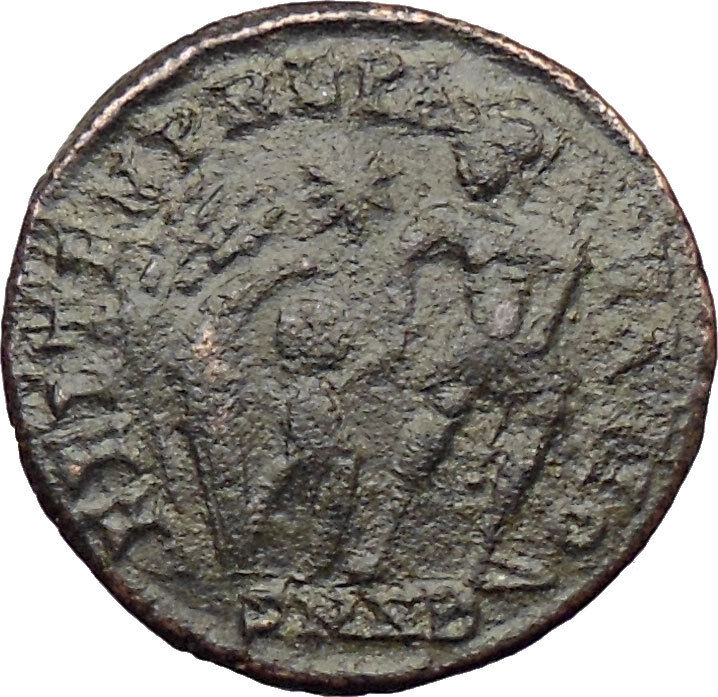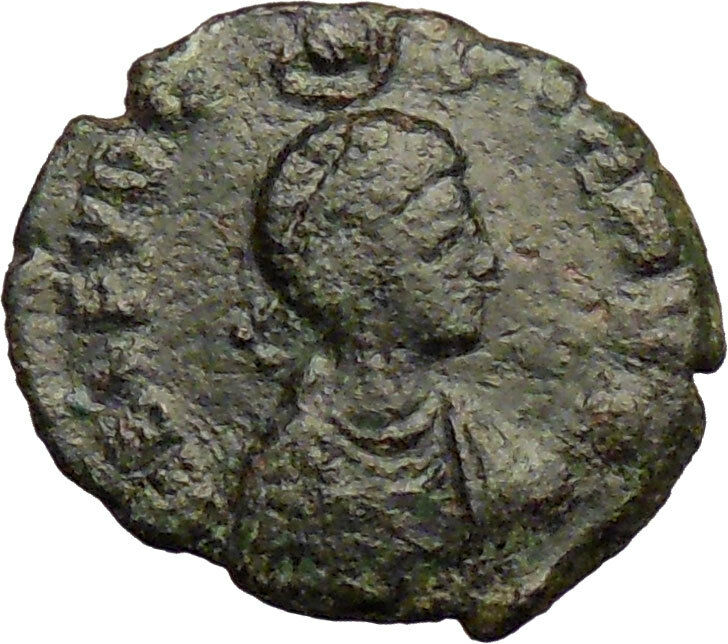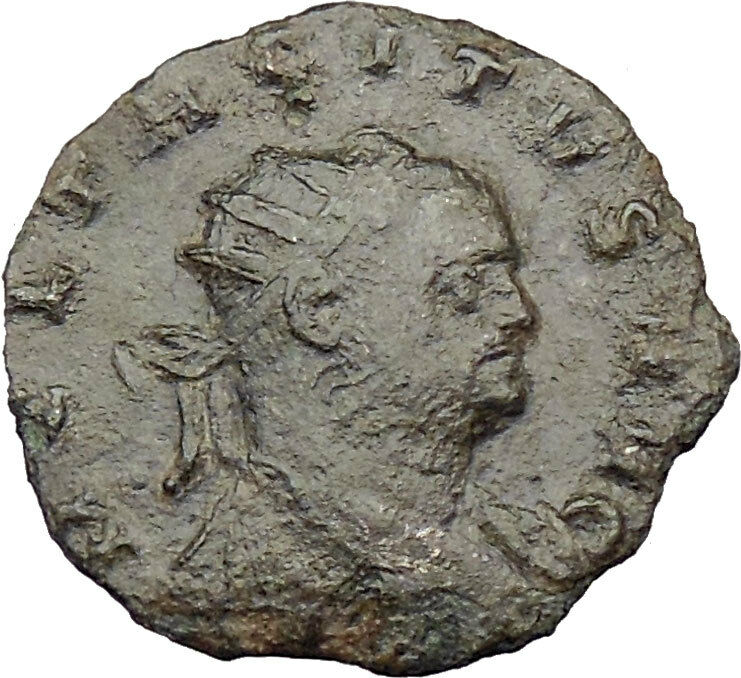|
Gordian III –
Roman Emperor
: 238-244 A.D. –
Silver Antoninianus 21mm (2.04 grams) Struck 239 A.D.
Reference: RIC 143, C 97
IMPGORDIANVSPIVSFELAVG – Radiate, draped and cuirassed bust right.
FORTREDVX – Fortuna seated left, holding rudder and cornucopia.
You are bidding on the exact
item pictured, provided with a Certificate of Authenticity and Lifetime
Guarantee of Authenticity.
Fortuna (Latin:
Fortūna, equivalent to the
Greek
goddess
Tyche
) was the goddess of fortune and
personification
of
luck in
Roman religion
. She might bring good luck or
bad: she could be represented as veiled and blind, as in modern depictions of
Justice
, and came to represent life’s
capriciousness. She was also a goddess of
fate
: as Atrox Fortuna, she claimed the
young lives of the
princeps
Augustus
‘ grandsons
Gaius
and
Lucius
, prospective heirs to the Empire.
Her father was said to be Jupiter and like him, she could also be bountiful .
As
Annonaria
she protected grain supplies.
June 11 was sacred to her: on June 24 she was given cult at the festival of
Fors Fortuna
.
Cult

Fortuna and Pontos
Fortuna’s Roman cult was variously attributed to
Servius Tullius
– whose exceptional good
fortune suggested their sexual intimacy – and to
Ancus Marcius
. The two earliest temples
mentioned in Roman Calendars were outside the city, on the right bank of the
Tiber (in Italian
Trastevere
). The first temple dedicated to Fors
was attributed to the Etruscan Servius Tullius, while the second is known to
have been built in 293 BC as the fulfilment of a Roman promise made during later
Etruscan wars
The date of dedication of her
temples was 24 June, or Midsummer’s Day, when celebrants from Rome annually
floated to the temples downstream from the city. After undisclosed rituals they
then rowed back, garlanded and inebriated. Also Fortuna had a temple at the
Forum Boarium
. Here Fortuna was twinned with
the cult of
Mater Matuta
(the goddesses shared a festival
on 11 June), and the paired temples have been revealed in the excavation beside
the church of
Sant’Omobono
: the cults are indeed archaic in
date. Fortuna Primigenia of
Praeneste
was adopted by Romans at the end of
3rd BC in an important cult of Fortuna Publica Populi Romani (the
Official Good Luck of the Roman People) on the
Quirinalis
outside the
Porta Collina
. No temple at Rome, however,
rivalled the magnificence of the Praenestine sanctuary.
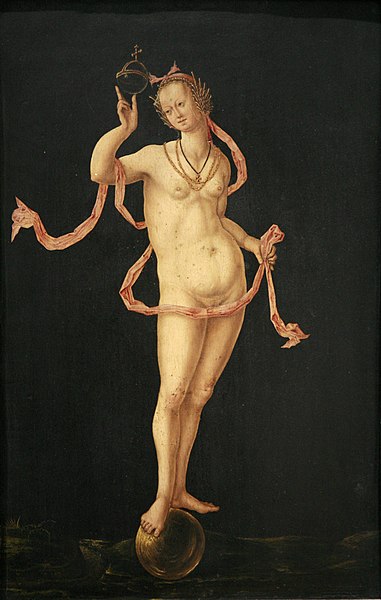
Fortuna lightly balances the
orb
of sovereignty between thumb
and finger in a Dutch painting of ca 1530
(Musée
des Beaux-Arts de Strasbourg)
Fortuna’s identity as personification of chance events was closely tied to
virtus
(strength of character). Public
officials who lacked virtues invited ill-fortune on themselves and Rome:
Sallust
uses the infamous
Catiline
as illustration – “Truly, when in the
place of work, idleness, in place of the
spirit of measure and equity
, caprice and pride
invade, fortune is changed just as with morality”.
An oracle
at the
Temple of Fortuna Primigena
in
Praeneste
used a form of divination in which a
small boy picked out one of various futures that were written on
oak
rods. Cults to Fortuna in her many forms are attested throughout the Roman
world. Dedications have been found to Fortuna Dubia (doubtful fortune),
Fortuna Brevis (fickle or wayward fortune) and Fortuna Mala (bad
fortune).
She is found in a variety of domestic and personal contexts. During the early
Empire, an amulet from the
House of Menander
in
Pompeii
links her to the Egyptian goddess
Isis, as Isis-Fortuna.[11]
She is functionally related to the God
Bonus Eventus
, who is often represented as her
counterpart: both appear on
amulets
and intaglio
engraved gems
across the Roman world.
Her name seems to derive from Vortumna (she who revolves the year).
The cornucopia (from Latin cornu copiae) or horn of plenty
is a symbol of abundance and nourishment, commonly a large horn-shaped container
overflowing with produce, flowers, nuts, other edibles, or wealth in some form.
Originating in
classical antiquity
, it has continued as a
symbol in
Western art
, and it is particularly associated
with the
Thanksgiving
holiday in
North America
.

Allegorical
depiction of the Roman
goddess
Abundantia
with a cornucopia, by
Rubens
(ca. 1630)
In Mythology
Mythology
offers multiple
explanations of the origin
of the cornucopia.
One of the best-known involves the birth and nurturance of the infant
Zeus, who had to be hidden from his devouring father
Cronus
. In a cave on
Mount Ida
on the island of
Crete
, baby Zeus was cared for and protected by
a number of divine attendants, including the goat
Amalthea
(“Nourishing Goddess”), who fed him
with her milk. The suckling future king of the gods had unusual abilities and
strength, and in playing with his nursemaid accidentally broke off one of her
horns
, which then had the divine power to
provide unending nourishment, as the foster mother had to the god.
In another myth, the cornucopia was created when
Heracles
(Roman
Hercules
) wrestled with the river god
Achelous
and wrenched off one of his horns;
river gods were sometimes depicted as horned. This version is represented in the
Achelous and Hercules
mural painting
by the
American Regionalist
artist
Thomas Hart Benton
.
The cornucopia became the attribute of several
Greek
and
Roman deities
, particularly those associated
with the harvest, prosperity, or spiritual abundance, such as personifications
of Earth (Gaia
or
Terra
); the child
Plutus
, god of riches and son of the grain
goddess Demeter
; the
nymph
Maia
; and
Fortuna
, the goddess of luck, who had the power
to grant prosperity. In
Roman Imperial cult
, abstract Roman deities who
fostered peace (pax
Romana) and prosperity were also depicted with a cornucopia,
including Abundantia
, “Abundance” personified, and
Annona
, goddess of the
grain supply to the city of Rome
.
Pluto
, the classical ruler of the underworld in
the
mystery religions
, was a giver of agricultural,
mineral and spiritual wealth, and in art often holds a cornucopia to distinguish
him from the gloomier Hades
, who holds a
drinking horn
instead.
Modern depictions
In modern depictions, the cornucopia is typically a hollow, horn-shaped
wicker basket filled with various kinds of festive
fruit
and
vegetables
. In North America, the cornucopia
has come to be associated with
Thanksgiving
and the harvest. Cornucopia is
also the name of the annual November Wine and Food celebration in
Whistler
, British Columbia, Canada. Two
cornucopias are seen in the
flag
and
state seal
of
Idaho
. The Great
Seal
of
North Carolina
depicts Liberty standing and
Plenty holding a cornucopia. The coat of arms of
Colombia
,
Panama
,
Peru and
Venezuela
, and the Coat of Arms of the State of
Victoria, Australia
, also feature the
cornucopia, symbolising prosperity.
The horn of plenty is used on body art and at Halloween, as it is a symbol of
fertility, fortune and abundance.
-
Base of a statue of
Louis XV of France
A rudder is a device used to steer a
ship, boat
,
submarine
,
hovercraft
,
aircraft
, or other conveyance that moves
through a medium (generally air or water). On an aircraft the rudder is used
primarily to counter
adverse yaw
and
p-factor
and is not the primary control used to
turn the airplane. A rudder operates by redirecting the fluid past the hull or
fuselage, thus imparting a turning or yawing motion to the craft. In basic form,
a rudder is a flat plane or sheet of material attached with
hinges
to the craft’s stern, tail, or after
end. Often rudders are shaped so as to minimize hydrodynamic or aerodynamic
drag
. On simple watercraft, a
tiller
—essentially, a stick or pole acting as a
lever arm—may be attached to the top of the rudder to allow it to be turned by a
helmsman
. In larger vessels, cables, pushrods,
or hydraulics may be used to link rudders to steering wheels. In typical
aircraft, the rudder is operated by pedals via mechanical linkages or
hydraulics.
History of the rudder
Generally, a rudder is “part of the steering apparatus of a boat or ship that
is fastened outside the hull”, that is denoting all different types of oars,
paddles, and rudders. More specifically, the steering gear of ancient vessels
can be classified into side-rudders and stern-mounted rudders, depending on
their location on the ship. A third term,
steering oar
, can denote both types. In a
Mediterranean
context, side-rudders are more
specifically called quarter-rudders as the later term designates more exactly
the place where the rudder was mounted. Stern-mounted rudders are uniformly
suspended at the back of the ship in a central position, but the term has
historically been found wanting because it does not take into account that the
stern rudders were attached to the ship
hull
in quite a different way: While the
European
pintle
-and-gudgeon
rudder was attached to the sternpost by pivoting iron fastenings, the
Arabs
used instead a system of lashings.
Chinese
stern rudders also featured
tackles
, but, unlike their medieval and Arab
counterparts, had no sternpost to which to attach them.
Roman
and particularly
ancient Egyptian
stern rudders featured again a
different method of fastening where the stock, having a single point of contact
with the stern, was additionally secured to the ship body by an upright
rudderpost or braced ropes.
Although Lawrence Mott in his comprehensive treatment of the history of the
rudder, Timothy Runyan, the Propyläen History of Technology, the
Encyclopædia Britannica
, and The Concise
Oxford Dictionary
of English Etymology classify
a steering oar as a rudder,[2]
Joseph Needham
,
Lefèbre des Noëttes
, K.S. Tom, Chung Chee Kit,
S.A.M. Adshead, John K. Fairbank, Merle Goldman, Frank Ross, and Leo Block state
that the steering oar used in ancient Egypt and Rome (and even ancient China)
was not a true rudder; the steering oar has the capacity to interfere with
handling of the sails (limiting any potential for long ocean-going voyages)
while it was fit more for small vessels on narrow, rapid-water transport; the
rudder did not disturb the handling of the sails, took less energy to operate by
its helmsman
, was better fit for larger vessels on
ocean-going travel, and first appeared in
ancient China
during the 1st century AD In
regards to the ancient
Phoenician
(1550–300 BC) use of the steering
oar without a rudder
in the Mediterranean
, Leo Block (2003) writes:
A single sail tends to turn a vessel in an upwind or downwind direction,
and rudder action is required to steer a straight course. A steering oar was
used at this time because the rudder had not yet been invented. With a
single sail, a frequent movement of the steering oar was required to steer a
straight course; this slowed down the vessel because a steering oar (or
rudder) course correction acts like a brake. The second sail, located
forward, could be trimmed to offset the turning tendency of the main sail
and minimize the need for course corrections by the steering oar, which
would have substantially improved sail performance.
Ancient Egypt
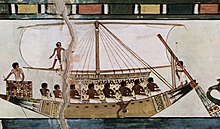
Stern-mounted steering oar of an Egyptian riverboat depicted in the
Tomb of Menna (c. 1422-1411 BC)
Rowing oars set aside for steering appeared on large Egyptian vessels long
before the time of Menes
(3100 BC). In the
Old Kingdom
(2686 BC-2134 BC) as much as five
steering oars are found on each side of passenger boats. The
tiller
, at first a small pin run through the
stock of the steering oar, can be traced to the fifth dynasty (2504–2347 BC).
Both the tiller and the introduction of an upright steering post abaft reduced
the usual number of necessary steering oars to one each side. Apart from
side-rudders, single rudders put on the stern can be found in a number of tomb
models of the time,particularly during the
Middle Kingdom
when tomb reliefs suggests them
commonly employed in Nile
navigation. The first literary reference
appears in the works of the
Greek
historian
Herodot
(484-424 BC), who had spent several
months in Egypt
: “They make one rudder, and this is
thrust through the keel
“, probably meaning the crotch at the end
of the keel (see right pic “Tomb of Menna”).
In Iran
, oars mounted on the side of ships for
steering are documented from the 3rd millennium BCE in artwork, wooden models,
and even remnants of actual boats.
Ancient Rome

Stern-mounted rudder of a Roman boat, 1st century AD (RG-Museum,
Cologne).
Roman navigation used sexillie quarter rudders which went in the
Mediterranean through a long period of constant refinement and improvement, so
that by Roman times ancient vessels reached extraordinary sizes. The strength of
the quarter rudder lay in its combination of effectiveness, adaptability and
simpleness. Roman quarter rudder mounting systems survived mostly intact through
the medieval period.
By the first half of the 1st century AD, rudders mounted on the stern were
also quite common in
Roman
river and harbour craft as proved from
reliefs
and archaeological finds (Zwammderdam,
Woerden
7). A tomb plaque of
Hadrianic
age shows a harbour tug boat in
Ostia
with a long stern-mounted oar for better
leverage. Interestingly, the boat already featured a
spritsail
, adding to the mobility of the
harbour vessel. Further attested Roman uses of stern-mounted rudders includes
barges under tow, transport ships for wine casks, and diverse other ship
typesAlso, the well-known
Zwammerdam
find, a large river barge at the
mouth of the Rhine, featured a large rudder mounted on the stern. According to
new research, the advanced
Nemi ships
, the palace barges of emperor
Caligula
(37-41 AD), may have featured 14 m
long stern-mounted rudders.
Medieval Near East
Arab
ships also used a sternpost-mounted
rudder, but which differed technically from both its European and Chinese
counterparts, indicating an independent invention.[39]
On their ships “the rudder is controlled by two lines, each attached to a
crosspiece mounted on the rudder head perpendicular to the plane of the rudder
blade.” The earliest evidence comes from the Ahsan al-Taqasim fi Marifat al-Aqalim
(‘The Best Divisions for the Classification of Regions’) written by
al-Muqaddasi
in 985:
- The captain from the crow’s nest carefully observes the sea. When a
rock is espied, he shouts: “Starboard!” or ‘Port!” Two youths, posted there,
repeat the cry. The helmsman, with two ropes in his hand, when he hears the
calls tugs one or the other to the right or left. If great care is not
taken, the ship strikes the rocks and is wrecked.
Arabs
used instead a system of lashings.
Chinese
stern rudders also featured
tackles
, but, unlike their medieval and Arab
counterparts, had no sternpost to which to attach them.[2]
According to Lawrence V. Mott, the “idea of attaching the rudder to the
sternpost in a relatively permanent fashion, therefore, must have been an Arab
invention independent of the Chinese.”
Medieval Europe

Pintle
-and-gudgeon
rudder of the
Hanseatic league
flagship
Adler von Lübeck
(1567–1581), the
largest ship in the world at its time
Oars mounted on the side of ships evolved into quarter rudders, which were
used from
antiquity
until the end of the
Middle Ages
in
Europe
. As the size of ships and the height of
the freeboards increased, quarter-rudders became unwieldy and were replaced by
the more sturdy stern-mounted rudders with
pintle
and
gudgeon
attachment. While stern-mounted rudders
were found in Europe on a wide range of vessels since Roman times, including
light war galleys in Mediterranean, the oldest known depiction of a pintle-and-gudgeon
rudder can be found on church carvings of
Zedelgem
and
Winchester
dating to around 1180.

A ship’s rudder carved in oak, 15th century,
Bere Ferrers
church, Devon.
Heraldic
badge
of Cheyne and Willoughby
families
Historically, the radical concept of the medieval pintle-and-gudgeon rudder
did not come as a single invention into being. It presented rather a combination
of ideas which each had been long around before: rudders mounted on the stern,
iron hinges and the straight sternpost of
northern European ships
. While earlier rudders
were mounted on the stern by the way of rudderposts or tackles, the iron hinges
allowed for the first time to attach the rudder to the entire length of the
sternpost in a really permanent fashion. However, its full potential could only
to be realized after the introduction of the vertical sternpost and the
full-rigged ship in the 14th century. From the
age of discovery
onwards, European ships with
pintle-and-gudgeon rudders sailed successfully on all seven seas.
Contrary to an older hypothesis, all evidence indicates that the European
hinged stern-mounted rudder, whose technical specifications considerably differ
from the Chinese one, was invented independently:
- The only actual concept which can be claimed to have been transmitted
from the Chinese is the idea of a stern-mounted rudder, and not its method
of attachment nor the manner in which it was controlled. Since that idea of
putting a rudder on the stern can be traced back to the models found in
Egyptian tombs, the need to have the concept brought into the Middle East is
questionable at best. There is no evidence to support the contention that
the sternpost-mounted rudder came from China, and no need to call on
exterior sources for its introduction into the Mediterranean.
Boat rudders details
Boat rudders may be either outboard or inboard. Outboard rudders are hung on
the stern or transom. Inboard rudders are hung from a keel or skeg and are thus
fully submerged beneath the hull, connected to the steering mechanism by a
rudder post which comes up through the hull to deck level, often into a cockpit.
Inboard keel hung rudders (which are a continuation of the aft trailing edge of
the full keel) are traditionally deemed the most damage resistant rudders for
off shore sailing. Better performance with faster handling characteristics can
be provided by skeg hung rudders on boats with smaller fin keels.
Rudder post and mast placement defines the difference between a ketch and a
yawl, as these two-masted vessels are similar. Yawls are defined as having the
mizzen mast abaft (i.e. “aft of”) the rudder post; ketches are defined as having
the mizzen mast forward of the rudder post.
Small boat rudders that can be steered more or less perpendicular to the
hull’s longitudinal axis make effective brakes when pushed “hard over.” However,
terms such as “hard over,” “hard to starboard,” etc. signify a maximum-rate turn
for larger vessels. Transom hung rudders or far aft mounted fin rudders generate
greater moment and faster turning than more forward mounted keel hung rudders.
There is also the barrel type rudder where the ships screw is enclosed
and can swiveled to steer the vessel. Designers claim that this type of rudder
on a smaller vessel will answer the helm faster.
Aircraft rudders
On an aircraft, the rudder is a directional
control surface
along with the rudder-like
elevator
(usually attached to horizontal tail
structure, if not a
slab elevator
) and
ailerons
(attached to the wings) that control
pitch and roll, respectively. The rudder is usually attached to the
fin
(or
vertical stabilizer
) which allows the pilot to
control
yaw
about the vertical axis, i.e. change the
horizontal direction in which the nose is pointing. The rudder’s direction in
aircraft since the “Golden Age” of flight between the two World Wars into the
21st century has been manipulated with the movement of a pair of foot pedals by
the pilot, while during the pre-1919 era rudder control was most often operated
with by a center-pivoted, solid “rudder bar” which usually had pedal and/or
stirrup-like hardware on its ends to allow the pilot’s feet to stay close to the
ends of the bar’s rear surface.
In practice, both aileron and rudder control input are used together to turn
an aircraft, the ailerons imparting roll, the rudder imparting yaw, and also
compensating for a phenomenon called
adverse yaw
. A rudder alone will turn a
conventional fixed-wing aircraft, but much more slowly than if ailerons are also
used in conjunction. Use of rudder and ailerons together produces co-ordinated
turns, in which the longitudinal axis of the aircraft is in line with the arc of
the turn, neither
slipping
(under-ruddered), nor skidding (over-ruddered).
Improperly ruddered turns at low speed can precipitate a
spin
which can be dangerous at low altitudes.
Sometimes pilots may intentionally operate the rudder and ailerons in
opposite directions in a maneuver called a
slip
. This may be done to overcome crosswinds
and keep the fuselage in line with the runway, or to more rapidly lose altitude
by increasing drag, or both. The pilots of
Air Canada Flight 143
used a similar technique
to land the plane as it was too high above the glideslope.
Any aircraft rudder is subject to considerable forces that determine its
position via a force or torque balance equation. In extreme cases these forces
can lead to loss of rudder control or even destruction of the rudder. (The same
principles also apply to water vessels, of course, but it is more important for
aircraft because they have lower engineering margins.) The largest achievable
angle of a rudder in flight is called its blowdown limit; it is achieved
when the force from the air or blowdown equals the maximum available hydraulic
pressure.
In multi-engined aircraft where the engines are off the centre line, the
rudder may be used to trim against the yaw effect of asymmetric thrust, for
example in the event of engine failure. Further, on large jet airliners, during
non-autopilot flight, the rudder is mainly used to compensate for side wind
composants. Turns can be done by the use of ailerons only. For taxing and during
the beginning of the take-off, large aircraft are steered by a special steering
wheel that is directly connected to the nose gear. Rudders (and ailerons) have
no or very little effect below airspeeds of around 50-60 knots. 80 knots is the
usual airspeed, at which the rudder (and thereby the pedals) gets more important
than the
nose gear steering
.
Trim tab
Trim tabs are small surfaces connected to the trailing edge of a
larger
control surface
, such as a rudder, on a
boat or
aircraft
, used to control the
trim
of the controls, i.e. to counteract hydro-
or aerodynamic forces and stabilise the boat or aircraft in a particular desired
attitude without the need for the operator to constantly apply a control force.
This is done by adjusting the angle of the tab relative to the larger surface.
Changing the setting of a trim tab adjusts the neutral or resting position of
a control surface (such as an
elevator
or rudder). As the desired position of
a control surface changes (corresponding mainly to different speeds), an
adjustable trim tab will allow the operator to reduce the manual force required
to maintain that position—to zero, if used correctly. Thus the trim tab acts as
a servo tab
. Because the
center of pressure
of the trim tab is further
away from the axis of rotation of the control surface than the center of
pressure of the control surface, the movement generated by the tab can match the
movement generated by the control surface. The position of the control surface
on its axis will change until the torque from the control surface and the trim
surface balance each other.
Marcus Antonius Gordianus Pius (January
20, 225
–
February
11
, 244
),
known in
English
as Gordian III,
 was was
Roman
Emperor
from 238 to 244. Gordian was the son of
Antonia Gordiana
and his father was an unnamed Roman Senator who died before
238. Antonia Gordiana was the daughter of Emperor
Gordian I
and younger sister of Emperor
Gordian II
.
Very little is known on his early life before becoming Roman Emperor. Gordian
had assumed the name of his maternal grandfather in 238.
Following the murder of emperor
Alexander Severus
in Moguntiacum (modern
Mainz
), the
capital of the
Roman province
Germania Inferior
,
Maximinus Thrax
was acclaimed emperor, despite strong opposition of the
Roman senate
and the majority of the population. In response to what was
considered in Rome as a rebellion, Gordian’s grandfather and uncle, Gordian I
and II, were proclaimed joint emperors in the
Africa Province
. Their revolt was suppressed within a month by Cappellianus,
governor of Numidia
and a loyal supporter of Maximinus Thrax. The elder Gordians died,
but public opinion cherished their memory as peace loving and literate men,
victims of Maximinus’ oppression.
Meanwhile, Maximinus was on the verge of marching on Rome and
the Senate elected
Pupienus
and Balbinus
as joint emperors. These senators were not popular men and the population of
Rome was still shocked by the elder Gordian’s fate, so that the Senate decided
to take the teenager Gordian, rename him Marcus Antonius Gordianus as his
grandfather, and raise him to the rank of
Caesar
and imperial heir.
Pupienus
and Balbinus
defeated Maximinus, mainly due to the defection of several
legions
,
namely the
Parthica II
who assassinated Maximinus. But their joint reign was
doomed from the start with popular riots, military discontent and even an
enormous fire that consumed Rome in June 238. On
July 29
,
Pupienus and Balbinus were killed by the
Praetorian guard
and Gordian proclaimed sole emperor.
Rule
Due to Gordian’s age, the imperial government was surrendered
to the aristocratic families, who controlled the affairs of Rome through the
senate. In 240,
Sabinianus
revolted in the African province, but the situation was dealt quickly. In 241,
Gordian was married to Furia Sabinia
Tranquillina
, daughter of the newly appointed praetorian prefect,
Timesitheus
. As chief of the Praetorian guard and father in law of the
emperor, Timesitheus quickly became the de facto ruler of the Roman
empire.
In the 3rd century, the Roman frontiers weakened against the
Germanic tribes across the
Rhine
and
Danube
, and the
Sassanid
kingdom across the
Euphrates
increased its own attacks. When the Persians under
Shapur I
invaded Mesopotamia
, the young emperor opened the doors of the
Temple of Janus
for the last time in Roman history, and sent a huge army to
the East. The Sassanids were driven back over the Euphrates and defeated in the
Battle of Resaena
(243). The campaign was a success and Gordian, who had
joined the army, was planning an invasion of the enemy’s territory, when his
father-in-law died in unclear circumstances. Without Timesitheus, the campaign,
and the emperor’s security, were at risk.
Marcus Julius Philippus, also known as
Philip the Arab
, stepped in at this moment as the new Praetorian Prefect and
the campaign proceeded. In the beginning of 244, the Persians counter-attacked.
Persian sources claim that a battle was fought (Battle
of Misiche) near modern
Fallujah
(Iraq)
and resulted in a major Roman defeat and the death of Gordian III[1].
Roman sources do not mention this battle and suggest that Gordian died far away,
upstream of the Euphrates. Although ancient sources often described Philip, who
succeeded Gordian as emperor, as having murdered Gordian at Zaitha (Qalat es
Salihiyah), the cause of Gordian’s death is unknown.
Gordian’s youth and good nature, along with the deaths of his
grandfather and uncle and his own tragic fate at the hands of another usurper,
granted him the everlasting esteem of the Romans. Despite the opposition of the
new emperor, Gordian was deified by the Senate after his death, in order to
appease the population and avoid riots.
|













 was
was
